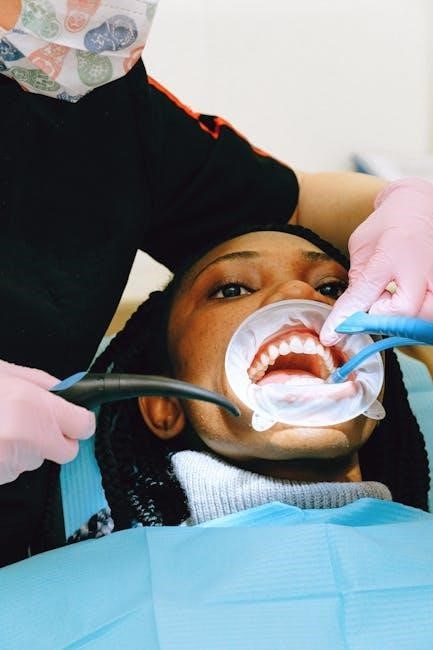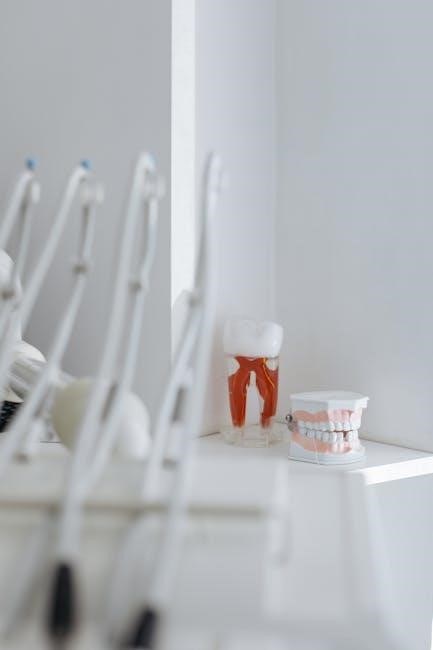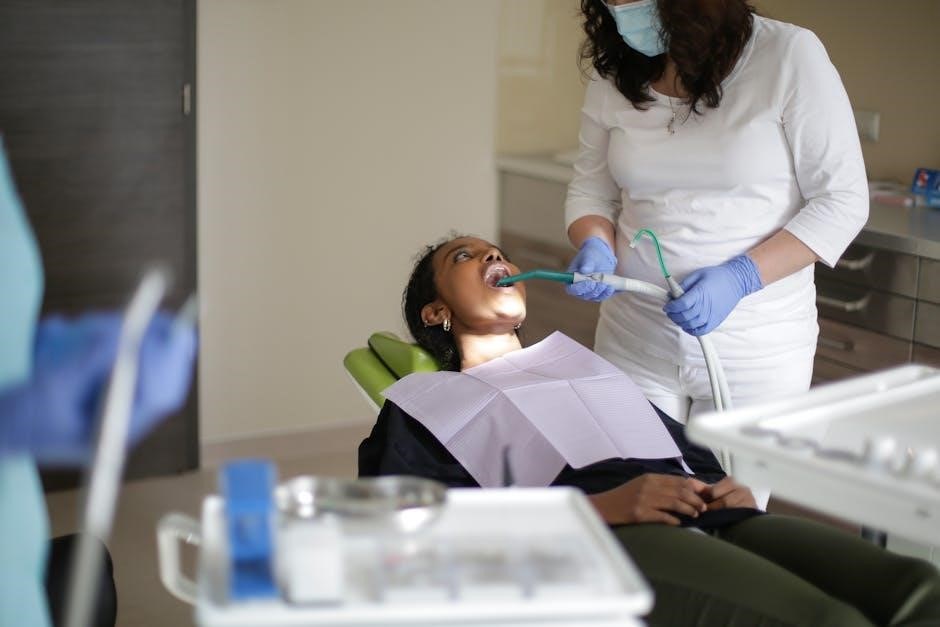
Dental Code D1330 refers to oral hygiene instructions‚ a procedure focused on educating patients about proper oral care practices‚ including tooth brushing‚ flossing‚ and using special hygiene aids.
Overview of Oral Hygiene Instructions
Oral hygiene instructions‚ categorized under Dental Code D1330‚ are personalized guidance provided by dental professionals to patients. These instructions aim to promote effective home care practices‚ such as proper tooth brushing techniques‚ flossing‚ and the use of special oral hygiene aids. The goal is to empower patients with the knowledge and skills necessary to maintain optimal oral health. Dental hygienists often tailor these instructions to address individual needs‚ ensuring patients understand how to prevent common issues like tooth decay‚ gingivitis‚ and plaque buildup. By emphasizing preventive care‚ oral hygiene instructions play a crucial role in reducing the risk of oral diseases and improving overall well-being. These guidelines are regularly updated to reflect the latest advancements in dental care‚ ensuring patients receive evidence-based advice. Effective oral hygiene practices not only enhance dental health but also contribute to systemic health by preventing conditions linked to poor oral care.
Importance of Dental Code D1330
Dental Code D1330 plays a vital role in promoting preventive oral care by providing patients with tailored guidance on maintaining good oral hygiene. This code emphasizes the importance of educating patients on proper techniques for tooth brushing‚ flossing‚ and using specialized oral hygiene tools. By focusing on personalized instruction‚ D1330 helps patients adopt habits that prevent common oral health issues such as tooth decay‚ gingivitis‚ and plaque buildup. Introduced in 2015‚ this code underscores the dental profession’s commitment to preventive care. It enables dental professionals to document and track patient education‚ ensuring consistency in care. The implementation of D1330 aligns with broader public health goals by reducing disparities in oral health and empowering individuals to take an active role in their well-being. Effective use of this code contributes to better oral health outcomes and reduces the need for more invasive treatments in the future.

Key Components of Oral Hygiene Instructions
Oral hygiene instructions cover essential practices like tooth brushing‚ flossing‚ and using special aids to maintain dental health and prevent issues like plaque and gingivitis.
Proper Tooth Brushing Techniques
Proper tooth brushing is a cornerstone of oral hygiene‚ involving the use of fluoride toothpaste and a soft-bristle toothbrush. Brushing should be done twice daily for two minutes‚ using gentle circular motions to clean all surfaces. The technique should focus on the gumline to prevent plaque buildup. Regular replacement of the toothbrush every three to four months ensures effectiveness. Dental professionals often demonstrate these methods during patient education sessions to promote consistent and effective oral care routines.
Effective Flossing Methods
Effective flossing involves using dental floss to remove plaque and food particles between teeth and under the gumline‚ areas a toothbrush cannot reach. The technique involves wrapping the floss around each tooth in a “C” shape and sliding it gently up and down. This method prevents damage to the gums and ensures thorough cleaning. Flossing should be done at least once daily to maintain oral health. Regular flossing helps prevent gingivitis and promotes healthy gums. It is an essential part of a comprehensive oral hygiene routine‚ complementing brushing and other hygiene practices. Proper flossing technique is often demonstrated by dental professionals during patient education sessions to ensure effectiveness and consistency.
Use of Special Oral Hygiene Aids
Special oral hygiene aids‚ such as interdental brushes‚ water flossers‚ and mouthwashes‚ play a crucial role in maintaining optimal oral health; These tools are designed to target areas that are difficult to reach with a standard toothbrush. Interdental brushes‚ for example‚ are ideal for cleaning between tightly spaced teeth‚ while water flossers use pressurized water to remove plaque and debris. Therapeutic mouthwashes can provide additional protection against gingivitis‚ bad breath‚ and tooth decay by delivering active ingredients. Patients with specific oral health needs‚ such as braces or dental implants‚ may benefit from these specialized aids. Dental professionals often recommend these tools as part of a personalized oral hygiene routine to ensure comprehensive care. Proper use of these aids‚ combined with regular brushing and flossing‚ can significantly enhance oral health outcomes and reduce the risk of dental complications.

Preventive Oral Healthcare
Preventive oral healthcare focuses on fluoride treatments and therapeutic mouthrinses to control conditions like gingivitis and plaque‚ promoting long-term oral health through education and regular care.
Fluoride Treatments and Their Role
Fluoride treatments are a cornerstone in preventive oral healthcare‚ playing a vital role in strengthening tooth enamel and preventing decay. As a natural mineral‚ fluoride helps remineralize teeth‚ making them more resistant to acid attacks from plaque and bacteria. Regular fluoride treatments‚ often applied in dental offices‚ are particularly beneficial for children and individuals at high risk of cavities. These treatments can be administered in various forms‚ including gels‚ foams‚ or varnishes‚ and are designed to provide an extra layer of protection. By incorporating fluoride treatments into oral hygiene routines‚ patients can significantly reduce the likelihood of tooth decay and promote long-term oral health. This preventive measure complements other hygiene practices‚ such as brushing and flossing‚ to create a comprehensive approach to maintaining a healthy smile.
Therapeutic Mouthrinses for Oral Health
Therapeutic mouthrinses are specialized oral care products designed to address specific dental concerns beyond basic oral hygiene. Unlike cosmetic mouthwashes‚ these solutions contain active ingredients that target conditions such as bad breath‚ gingivitis‚ and plaque buildup. For instance‚ mouthrinses with antibacterial agents like chlorhexidine are effective in reducing gingivitis and preventing the progression of periodontal disease. Additionally‚ fluoride-infused mouthrinses can strengthen tooth enamel and prevent decay. Some formulations also cater to sensitive teeth by blocking dentinal tubules to alleviate pain. When used as part of a comprehensive oral hygiene routine‚ therapeutic mouthrinses can enhance the effectiveness of brushing and flossing. Dentists often recommend these products based on individual patient needs‚ ensuring tailored care for optimal oral health outcomes. Regular use of therapeutic mouthrinses can significantly contribute to maintaining a healthy‚ disease-free smile and preventing future dental issues.

Dental Codes and Their Significance
Dental codes like D1330 standardize oral hygiene instructions‚ ensuring consistency in patient care and billing processes. They facilitate accurate insurance claims and data tracking‚ improving overall treatment outcomes and quality.
Understanding CDT Code D1330
CDT Code D1330 is specifically designated for oral hygiene instructions‚ covering essential practices like tooth brushing‚ flossing‚ and the use of special oral hygiene aids. Introduced in 2015‚ this code standardizes the documentation and billing process for patient education in dental care. It ensures that dental professionals can accurately report the time spent on educating patients about maintaining proper oral health. The code is vital for insurance claims and helps track the effectiveness of preventive care. By assigning a specific code to oral hygiene instructions‚ it emphasizes the importance of patient education in overall dental treatment plans. This code also facilitates consistency in recording and billing‚ making it easier for dental practices to manage patient care efficiently. Understanding D1330 is crucial for both dentists and patients‚ as it highlights the role of education in preventing oral health issues and promoting long-term dental wellness.
Reporting Multiple Quadrants with D4341/D4342
Codes D4341 and D4342 are used for periodontal maintenance procedures‚ with D4341 applying to one or two quadrants and D4342 for three or four quadrants. When reporting multiple quadrants during a single visit‚ these codes help standardize documentation. If more than two quadrants are treated‚ D4342 is typically used‚ and additional details may be required for insurance claims. These codes ensure accurate billing and reflect the extent of treatment provided. Proper use of D4341 and D4342 is essential for maintaining clear records and facilitating reimbursement. They also help differentiate between routine cleanings and more extensive periodontal care. Understanding these codes is vital for dental practices to ensure compliance with billing guidelines and provide transparent patient care. Accurate reporting with D4341 and D4342 supports efficient insurance processing and maintains the integrity of patient records.
Patient Education and Awareness
Patient education empowers individuals to maintain optimal oral health through personalized guidance‚ emphasizing proper hygiene practices and preventive care‚ delivered by dental professionals to enhance health outcomes.
Personalized Oral Hygiene Education
Personalized oral hygiene education tailors instructions to individual patient needs‚ focusing on specific techniques and tools to improve oral health. Dental professionals assess patients’ oral conditions‚ providing customized advice on brushing‚ flossing‚ and using aids like interdental brushes or mouthrinses. This approach addresses unique challenges‚ such as orthodontic appliances or sensitive teeth‚ ensuring effective home care routines. By understanding patient preferences and abilities‚ hygienists can recommend appropriate products and demonstrate proper techniques. Regular follow-ups allow for adjustments and reinforcement of good habits. Personalized education not only enhances patient engagement but also improves long-term oral health outcomes‚ making it a cornerstone of preventive dental care. This method ensures that patients receive relevant‚ actionable guidance‚ empowering them to maintain a healthier smile and prevent future oral issues effectively.
The Role of Dental Hygienists in Education
Dental hygienists play a vital role in oral health education‚ serving as key educators for patients. They assess individual oral health needs‚ provide personalized instructions‚ and demonstrate proper techniques for brushing‚ flossing‚ and using hygiene aids. By using tools like phantom heads and real patient cases‚ hygienists develop practical skills to effectively communicate oral hygiene strategies. Their education focuses on preventive care‚ empowering patients to maintain good oral health independently. Hygienists also adapt their teaching methods to accommodate different patient needs‚ ensuring the information is engaging and easy to understand. Regular follow-ups allow them to reinforce good habits and address any new concerns. Through patient education‚ dental hygienists contribute significantly to improving oral health outcomes and preventing future dental issues‚ making them essential advocates for long-term oral wellness.

Oral Health Promotion
Oral health promotion involves educating communities about good hygiene practices and preventive care. Campaigns like World Oral Health Day raise awareness‚ aiming to improve global oral health outcomes effectively.
World Oral Health Day and Its Impact
World Oral Health Day (WOHD)‚ established by the FDI World Dental Federation in 2007‚ is the largest global awareness campaign for oral health; Celebrated annually on March 20th‚ it aims to promote good oral hygiene practices‚ prevent diseases‚ and improve overall health. The day emphasizes the importance of oral health as part of general well-being‚ targeting schools‚ communities‚ and policymakers worldwide. Activities include educational events‚ free dental check-ups‚ and distribution of oral hygiene resources. WOHD also highlights the link between oral health and systemic diseases like diabetes and heart disease. Its impact is significant‚ fostering awareness and encouraging individuals to adopt healthier habits. By addressing barriers to care‚ WOHD supports equitable access to oral health services. This initiative aligns with dental codes like D1330‚ which standardize oral hygiene education‚ ensuring consistent and effective patient care globally.
Public Awareness Campaigns for Oral Health
Public awareness campaigns for oral health are vital in promoting dental hygiene and preventing oral diseases. These campaigns utilize various strategies‚ including educational materials‚ community events‚ and media outreach‚ to educate the public on proper oral care practices. Collaborations with schools and dental professionals help disseminate information on the importance of regular brushing‚ flossing‚ and dental visits. These initiatives also emphasize the connection between oral health and overall well-being‚ addressing issues like tooth decay and gum disease. Dental codes such as D1330 contribute to these efforts by standardizing oral hygiene instructions‚ ensuring patients receive consistent guidance. The impact of these campaigns is profound‚ leading to improved oral health outcomes and a reduction in preventable dental issues. Consequently‚ public awareness campaigns are indispensable for fostering a healthier community and advancing long-term oral health.

Addressing Barriers to Oral Health
Lack of access to dental care in rural areas and economic challenges hinder oral health outcomes‚ emphasizing the need for targeted solutions to ensure equitable dental hygiene practices.
Access to Dental Care in Rural Areas
Access to dental care in rural areas remains a significant challenge‚ with limited availability of dental facilities and specialists. Many rural communities face barriers such as long travel distances to dental clinics and a shortage of qualified practitioners. These challenges often result in delayed or untreated dental issues‚ leading to poorer oral health outcomes. The lack of access disproportionately affects low-income and marginalized populations‚ exacerbating existing health inequities. Despite these hurdles‚ oral hygiene instructions play a vital role in improving oral health in these regions. Educating patients on proper tooth brushing‚ flossing‚ and the use of fluoride can help mitigate the impact of limited dental care access. Innovative solutions‚ such as mobile dental clinics and telehealth services‚ are being explored to bridge the gap. Addressing these barriers is essential for promoting equitable oral health care and preventing complications from untreated dental conditions.
Overcoming Economic Barriers to Oral Health
Economic barriers significantly impact access to oral health care‚ particularly for low-income populations. High costs of dental services and lack of insurance coverage often prevent individuals from seeking timely treatment. To address this‚ many dental practices offer sliding scale fees or financing options to make care more affordable. Government programs and non-profit organizations also provide financial assistance for dental care‚ reducing the burden on economically disadvantaged individuals. Additionally‚ community clinics and outreach programs play a crucial role in delivering low-cost or free dental services‚ including oral hygiene instructions. By providing affordable access to preventive care‚ such as fluoride treatments and therapeutic mouthrinses‚ these initiatives help reduce the need for more costly interventions. Educating patients about the importance of oral hygiene can also empower them to maintain better oral health‚ thereby reducing the economic strain of untreated dental issues.
Dental Code D1330 emphasizes the importance of oral hygiene education in preventing dental issues. Proper techniques and personalized care promote long-term oral health‚ benefiting overall well-being significantly.
Effective oral hygiene begins with proper tooth brushing using a fluoride toothpaste‚ brushing all surfaces for two minutes‚ twice daily. Flossing is essential for removing plaque between teeth‚ where a toothbrush cannot reach. Using interdental brushes or water flossers can enhance cleaning for those with tight spaces or orthodontic appliances. Fluoride treatments strengthen enamel‚ preventing decay‚ while therapeutic mouthwashes target specific issues like gingivitis or bad breath. Regular dental check-ups ensure early detection of problems and personalized care. Education from dental hygienists plays a crucial role in tailoring routines to individual needs‚ improving adherence and outcomes. Consistency in these practices reduces the risk of oral diseases‚ promoting a healthier smile and overall well-being. By combining these strategies‚ patients can maintain optimal oral health and prevent future complications.
Future Directions in Oral Health Education
Advancements in oral health education are expected to focus on personalized approaches‚ leveraging technology to enhance patient engagement. The development of new dental diagnostic codes and clinical practice guidelines will improve the quality of care. Digital tools‚ such as mobile apps and AI-driven platforms‚ will play a significant role in delivering tailored oral hygiene instructions. Tele-dentistry is likely to expand‚ making oral health education more accessible‚ especially in rural areas. Community-based programs and partnerships with schools will further promote preventive care. Emphasizing the importance of early intervention and lifelong oral health habits will remain central to education strategies. By integrating innovative methods and addressing barriers to care‚ future oral health education will aim to reduce disparities and improve overall population health.
 invisalign instructions
invisalign instructions  singer sew mate 5400 instruction manual
singer sew mate 5400 instruction manual  moultrie game camera instructions manual
moultrie game camera instructions manual  weaver instructional systems
weaver instructional systems  10×10 gazebo assembly instructions
10×10 gazebo assembly instructions  magnitude vape pen instructions
magnitude vape pen instructions  manual toro tmc 212
manual toro tmc 212  u.s. coin book pdf
u.s. coin book pdf  hobbit pdf
hobbit pdf